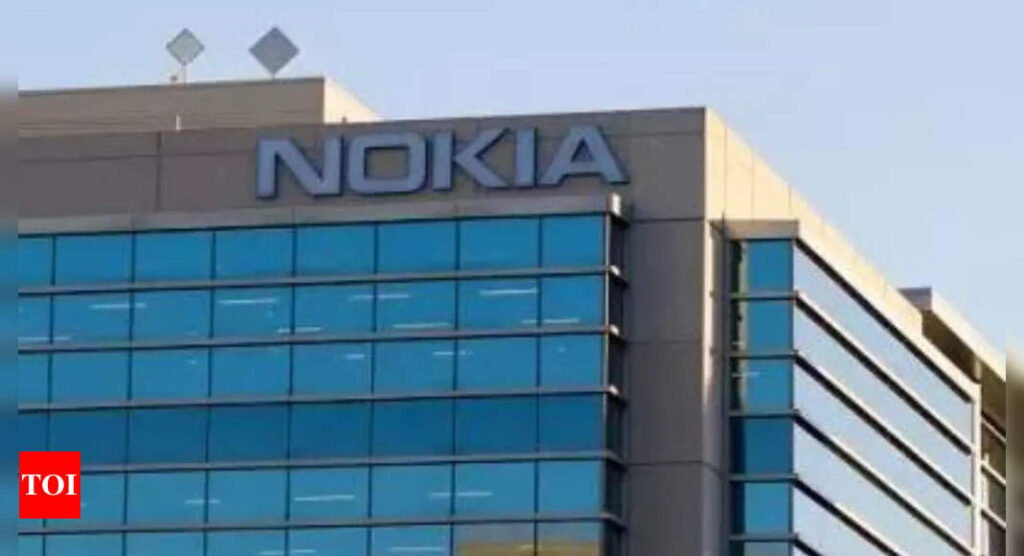[ad_1]
NEW DELHI: While Indian telecom operators have completed the roll-out of 5G network across the country, Nokia sees demand for equipment will be substantial in 2024-25, a senior company official said. Speaking to PTI at the India Mobile Congress, Nokia India head of mobile networks business Tarun Chhabra said that the proliferation of fixed wireless access network will usher the Indian telecom sector into the second phase of 5G network deployment.
“India’s requirement is still going to be substantial in 2024-25, then our factories will be fully loaded with India plus some exports,” Chhabra said.
Nokia has recorded multi-fold growth in its telecom gear business in India on account of rapid 5G network deployment.
In the third quarter financial report, Nokia President and CEO Pekka Lundmark said the business continued to benefit from 5G deployments in India, where net sales more than doubled year-on-year, but sales volume moderated significantly on a sequential basis as the pace of deployment has started to normalise.
Chhabra said that Nokia will increase exports from India if demand tapers, but he expects the growth momentum in the country to continue.
“Fixed wireless Access (FWA) is one big thing that can actually require a lot of data thrusting and then operators will have to actually deploy more networks. I would say this is Phase one. Once there is a new use case coming up, more subscribers being added, then there’s going to be more demand for network capacity, which is also going to have an impact on the second phase of 5G deployment,” Chhabra said.
The FWA technology is helping mobile operators connect new homes without laying optical fibre cable and provide high-speed broadband to homes.
Chhabra said that use cases in ports, manufacturing, defence and railways, etc. have the potential to provide monetisation opportunity to telecom operators.
“Port, manufacturing, defence and railways, these are also going to open up an extra revenue stream for operators. Once they are able to get more money from these operations and also more subscribers, they will be moved to phase two expansion and that is what we are looking for,” he said.
Talking about 6G, Chhabra said that Nokia has set up a 6G sensing lab in Bengaluru where the company also has a huge research and development centre with around 8,000 engineers.
“We have a very huge setup in Bengaluru and which is more on Nokia R&D. We now have more people who are going to work on 6G standardisation and 6G features. In this lab, this number will only go up. We are going to collaborate with the other agencies, like academia, regarding how we can add more and more IPRs in 6G to fulfil the aim of India,” Chhabra said.
“India’s requirement is still going to be substantial in 2024-25, then our factories will be fully loaded with India plus some exports,” Chhabra said.
Nokia has recorded multi-fold growth in its telecom gear business in India on account of rapid 5G network deployment.
In the third quarter financial report, Nokia President and CEO Pekka Lundmark said the business continued to benefit from 5G deployments in India, where net sales more than doubled year-on-year, but sales volume moderated significantly on a sequential basis as the pace of deployment has started to normalise.
Chhabra said that Nokia will increase exports from India if demand tapers, but he expects the growth momentum in the country to continue.
“Fixed wireless Access (FWA) is one big thing that can actually require a lot of data thrusting and then operators will have to actually deploy more networks. I would say this is Phase one. Once there is a new use case coming up, more subscribers being added, then there’s going to be more demand for network capacity, which is also going to have an impact on the second phase of 5G deployment,” Chhabra said.
The FWA technology is helping mobile operators connect new homes without laying optical fibre cable and provide high-speed broadband to homes.
Chhabra said that use cases in ports, manufacturing, defence and railways, etc. have the potential to provide monetisation opportunity to telecom operators.
“Port, manufacturing, defence and railways, these are also going to open up an extra revenue stream for operators. Once they are able to get more money from these operations and also more subscribers, they will be moved to phase two expansion and that is what we are looking for,” he said.
Talking about 6G, Chhabra said that Nokia has set up a 6G sensing lab in Bengaluru where the company also has a huge research and development centre with around 8,000 engineers.
“We have a very huge setup in Bengaluru and which is more on Nokia R&D. We now have more people who are going to work on 6G standardisation and 6G features. In this lab, this number will only go up. We are going to collaborate with the other agencies, like academia, regarding how we can add more and more IPRs in 6G to fulfil the aim of India,” Chhabra said.
[ad_2]
Source link











More Stories
India’S Growth Forecast: S&P ups India’s FY’24 growth forecast to 6.4% on robust domestic momentum
India to remain fastest-growing major economy, but demand uneven: Poll
Jack Ma: Jack Ma gets back into business with ‘Ma’s Kitchen Food’